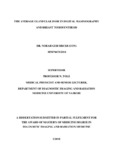The Average Glandular Dose in Digital Mammography and Breast Tomosynthesis
Abstract
Background and Purpose: Imaging is essential for accurate breast diagnosis and early detection of breast cancer. Population screening with mammography is the only intervention proven to reduce mortality from breast cancer through early detection. The Government of Kenya therefore embarked on a program to equip all county hospitals with digital mammography machines. Because mammography uses ionizing radiation, any exposure must be justified and doses kept as low as reasonably possible. Currently there are no studies that have been done in Kenya or Africa to determine whether the radiation doses are within acceptable dose reference ranges. The aim of this study was to determine the average glandular dose (AGD) in digital full-field mammography (2 D) and in breast tomosynthesis (3 D).
Study Design and Site: This was a cross sectional study carried out at Kenyatta National Hospital (KNH) using the GE Essential Senographe Digital Mammography unit recently installed at the radiology department of the Hospital.
Study Population: The study included patients referred for mammography at Kenyatta National hospital.
Sampling Method and Size: A total of 200 patients were included and the sequential sampling method was used to select the patients.
Study time: The study was conducted over a period of 4 months, November 2016- May 2017.
Materials and Methods: All patients included in the study had CC and MLO exposures of both breasts. Each patient’s data was recorded as provided by the machine. A dosimeter to measure radiation dose, was placed on a breast phantom which was placed on the mammogram machine and exposed to ionizing radiation.
A data collection sheet was used to record radiation doses obtained from cranial-caudal view during mammography and also included the AGD, ESE, kVp, and type of anode and filter material, CBT and MODE. The patient’s age was also recorded.
Main Outcome and Measures: Both the mean glandular doses automatically displayed by the digital mammography unit and those measured indirectly using TLD dosimeters on breast phantom were collected. The data was eventually analyzed using the statistical package for social scientists (SPSS) computer software package and the results presented in the form of tables, charts and graphs.
xvi
Results: The AGD values were 1.2±0.5mGy and 1.3±0.6 mGy for CC and MLO views respectively. The statistical difference of (-0.1) was significant. The number of patients who underwent breast tomosynthesis (3D) were too few and therefore not analyzed.
Conclusion: In this study the AGD values were within the recommended dose reference levels and also AGD values were higher in the CC compared to the MLO view having a statistical significant difference of (-0.1) that is in agreement with other previously reported studies.
The data has been made available to UON and KNH.
Publisher
University of Nairobi
Rights
Attribution-NonCommercial-NoDerivs 3.0 United StatesUsage Rights
http://creativecommons.org/licenses/by-nc-nd/3.0/us/Collections
The following license files are associated with this item:


